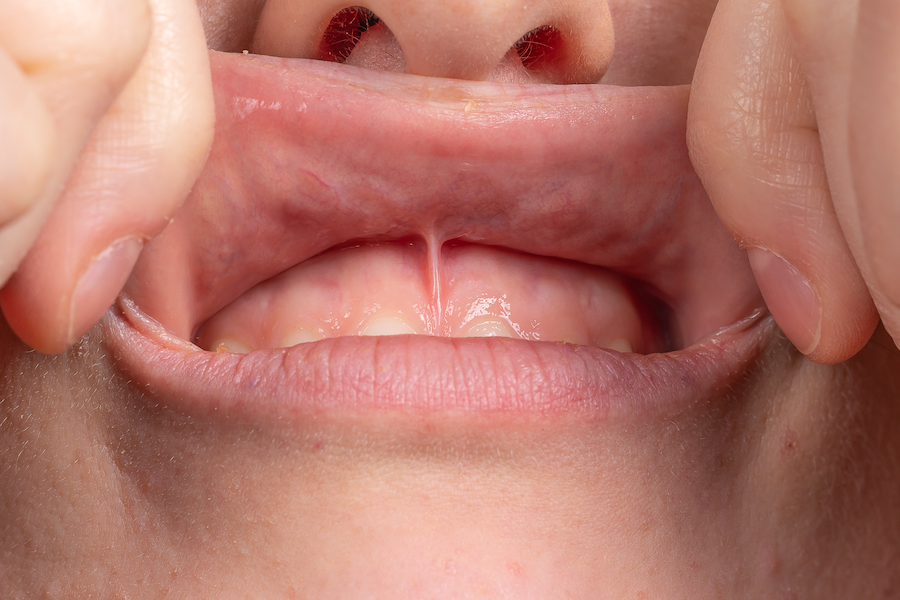Conditions of the Oral Cavity (Mouth): Labial Frenulum and Lingual Frenulum
Here are some consensus statements from experts to consider before undertaking a procedure on your child’s labial or lingual frenulum.
Ankyloglossia (“tongue tie” or “shortened lingual frenulum”)
Ankyloglossia (known as “tongue tie” or “shortened lingual frenulum”) is a condition of limited tongue mobility caused by a restrictive lingual frenulum. Releasing the band of tissue is called frenotomy or frenulotomy. In some communities, infants and children are being over-diagnosed with ankyloglossia. In some communities, a significant number of children are having unnecessary surgery on the lingual frenulum.
upper lip (maxillary Labial) Frenulum
The maxillary labial frenulum is a thin band of tissue attaching the upper lip to the gums between the central incisor teeth.
Presence of an upper lip frenulum is normal in an infant.
Upper lip tie is an inconsistently defined condition.
Upper lip tie has an unclear relationship to breastfeeding difficulties.
In some communities upper lip tie is being overdiagnosed.
Upper lip frenotomy in infants or children with primary dentition will not prevent the occurrence of a gap between the upper incisors.
VERY BRIEF SUMMARY on ankyloglossia (“tongue tie”)
When other causes of poor breastfeeding efficiency have been ruled out, frenotomy is reasonable. When mothers have nipple pain and understand that frenotomy is on average reported to reduce nipple pain, but there is no guarantee on an individual basis, frenotomy is reasonable. Complications of frenotomy are rare, and the procedure may be performed equally well with scissors as with a laser.
Consensus statements on breastfeeding and ankyloglossia
Breastfeeding difficulties are common in the newborn period and evidence shows that anterior ankyloglossia is a potential contributor to infant feeding problems.
Maternal pain and poor infant latch can be caused by ankyloglossia but these symptoms can also be present with other causes of breastfeeding difficulties.
Ankyloglossia in an infant should be evaluated by a careful history (including lactation history) and physical examination, including inspection and palpation.
The maternal and infant breastfeeding dyad should be recognized as a vulnerable patient population and care should be taken to ensure adequate support services, education and counseling, and shared decision making.
Infants should ideally be evaluated by a lactation consultant prior to lingual frenotomy.
Informed consent for lingual frenotomy should include mention of the possibility of failure to experience improvement in breastfeeding.
Before performing a frenotomy on an infant with breastfeeding difficulty, it is appropriate to evaluate the child for other potential head and neck sources of breastfeeding problems such as nasal obstruction, airway obstruction, laryngopharyngeal reflux, and craniofacial anomalies (eg cleft palate).
considerations before undertaking frenotomy
Patients and caregivers of patients with ankyloglossia should be informed on the non-surgical options of observation, lactation consultation, and/or speech-language pathology consultation.
Potential benefits from lingual frenotomy in the infant with breastfeeding difficulties are relief of maternal symptoms (eg less nipple pain) and maternal reported improvement in infant feeding. Maternal reported breastfeeding efficacy and nipple pain in the presence of ankyloglossia are on average improved with lingual frenotomy compared to no surgical treatment, but frenotomy is not always effective in relieving maternal pain and breastfeeding difficulty. Breastfeeding difficulty and maternal pain in the presence of ankyloglossia may resolve without surgical treatment.
risks and pain
Relative contraindications to infant frenotomy include, but are not limited to, retrognathia, micrognathia, neuromuscular disorder, hypotonia, and coagulopathy.
Lingual frenotomy is generally a safe and well-tolerated procedure.
Topical anesthetic agents are not recommended prior to infant frenotomy.
Injected anesthetic agents are not recommended prior to infant frenotomy.
Oral sucrose has been shown to decrease pain response in infants undergoing procedures and can be given to an infant prior to undergoing frenotomy.
Rare complications of lingual frenulotomy include hemorrhage, airway obstruction, injury to salivary structures, oral aversion, and scarring.
prevention of future problems
It is not necessary to perform lingual frenotomy in an infant with little or no restriction in tongue mobility to prevent a future feeding disorder.
It is not necessary to perform lingual frenotomy in an infant with little or no restriction in tongue mobility to prevent a future speech disorder.
Timing
Lingual frenotomy should ideally be performed as soon as possible after diagnosis of ankyloglossia in an infant with breastfeeding problems not improving with conservative management.
technique and post-procedure care
There is insufficient evidence to support claims that one technique of frenotomy, such as laser, is superior to other techniques.
After frenotomy is performed for ankyloglossia there is no evidence to support a standard post-procedure care regimen (eg stretching, massaging, manual elevation of the tongue by the parents).
Older children and ankyloglossia
Ankyloglossia does not typically affect speech.
A consultation with a speech pathologist is encouraged before frenotomy/frenuloplasty in an older child who is undergoing the procedure for speech concerns.
Ankyloglossia may cause social/mechanical issues in older children (difficulty licking, difficulty keeping teeth clean, lower central incisor diastema, sense of social embarrassment)
Some older children with social/mechanical issues related to ankyloglossia will experience improved quality of life after frenotomy/frenuloplasty.
There is no maximum age for a patient undergoing frenotomy/frenuloplasty.
There is not a preferred surgical procedure or technique for correction of ankyloglossia in the older child.
This page




